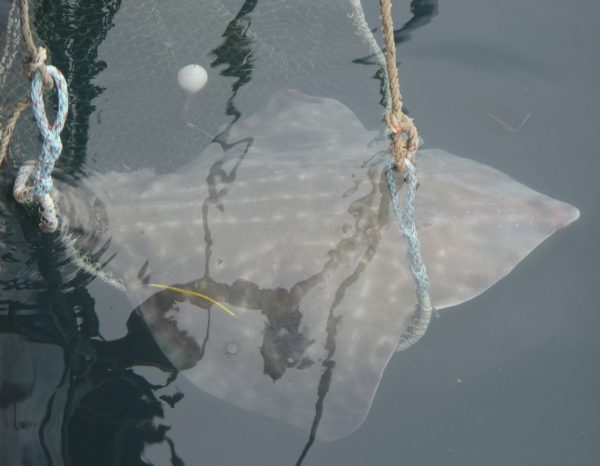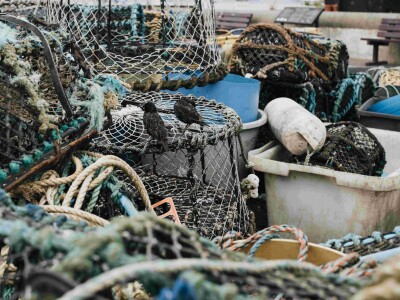Giant skates is another fishery that could get underway in Prince William Sound and other regions after more is learned about their life style and habits.
A giant skate is released after tagging. Thomas Farrugia photo.A few skate fisheries have occurred on and off in the central Gulf over the past decade. More recently, managers have put on the brakes because of the fast pace in which they can be caught, and the fact that little is known about Alaskan skates.
“There’s quite a bit of skate fishing going on in the Atlantic, both on the US and European side, but here in Alaska it’s hasn’t been a target for very long at all. So we really don’t know that much about them,” said Thomas Farrugia, a doctoral student at the UAF School of Fisheries and Ocean Sciences.
Farrugia and SFOS professor Andrew Seitz are studying whether there can be a sustainable and profitable fishery for big and long nose skates in the Gulf of Alaska. One thing they’ve learned in a year-long satellite tagging study is that skates really get around.
“It was previously thought that skates sit in one spot and look for crabs, clams and little fish to eat, but don’t have much need to move a whole lot like an oceanic predator,” Farrugia explained. “But it turns out big skates can move over hundreds of nautical miles, which we hadn’t been sure about before. The take away message is we have to look at the entire Gulf population as one big stock and not a bunch of subunits. And this will affect how the species is managed.”
Farrugia calls skates ‘flat sharks’ because the two are identical biologically. Both have a very slow life history and produce only two to eight offspring each time they mate. In Alaska, skates can fetch nice prices – 45 cents a pound for whole fish and a dollar a pound for skate wings frozen at sea.
“Fishermen, especially bottom trawlers or halibut and cod longliners, will catch quite a few skates and retain them because the price for them is fairly high, often higher than cod,” Farrugia said.
Currently, skates can only can be retained as five percent bycatch of a targeted catch, such as cod or halibut. About 4.5 million pounds are taken in Gulf fisheries each year.
It’s mostly fishermen in Prince William Sound, Seward and Homer who are pushing for a skate fishery, while others in Kodiak believe it would be best to leave skates as a bycatch portion in their other fisheries.
“There’s a sort of geographical divide,” Farrugia said. “If they do have a fishery, it would be a short season, maybe for a week, where all these boats would target skates and then not be able to fish them for the rest of the year. Others want to be able to retain skates as bycatch over a longer period of time.”
The next phase of Farrugia’s research is to create a Gulf-wide stock assessment model that could be used by fishery managers, followed by a bio-economic model that evaluates whether a skate fishery would be feasible.
“Until we know more about the biomass and what the sustainable level is, it is probably not going to be possible to have a profitable directed skate fishery because there is just not enough quota to go around,” Farrugia said.







